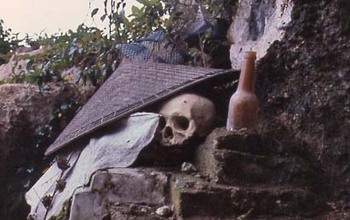Death Rites
African death rites

African death rites vary widely across the continent but often involve elaborate ceremonies celebrating the deceased's life, ancestral worship, and community gatherings to offer prayers and sacrifices.
Read MoreAsian death rites

Asian death rites encompass diverse practices, including ancestor worship, burning incense, and elaborate funerals. Each culture in Asia has unique traditions reflecting their beliefs about death and the afterlife.
Read MoreEuropean death rites

European death rites vary by region but generally involve church services, burial or cremation, and mourning periods. Traditions like wakes and memorial services are common across Europe.
Read MoreFitampoha

Fitampoha is a Malagasy ritual involving the exhumation and reburial of ancestors' remains. It is a significant cultural event, celebrated with music, dance, and feasting to honor the ancestors.
Read MoreMirila
Mirila are unique stone markers found in the Velebit region of Croatia. They are placed where the soul is believed to leave the body during the funeral procession, marking a spiritual resting point.
Read MoreNative American death rites

Native American death rites vary among tribes but often include ceremonies to honor the deceased's spirit. Practices may involve storytelling, drumming, and sacred rituals to guide the soul to the afterlife.
Read MoreObon

Obon is a Japanese Buddhist festival honoring deceased ancestors. Families clean graves, light lanterns, and perform traditional dances to welcome the spirits of the dead back home.
Read MoreThe day of the dead in Mexico

The Day of the Dead is a vibrant Mexican holiday celebrating deceased loved ones with altars, marigolds, sugar skulls, and family gatherings. It is a joyful occasion to honor and remember the dead.
Read MoreYahrtzeit
Yahrtzeit is the Jewish tradition of commemorating the anniversary of a loved one's death. It involves lighting a memorial candle, reciting prayers, and reflecting on the deceased's life and legacy.
Read MoreChinese funeral

Chinese funerals are marked by rituals to honor the deceased and ensure a peaceful journey to the afterlife. Practices include burning joss paper, offering food, and performing traditional mourning ceremonies.
Read MoreDeath anniversary

Death anniversaries, observed in many cultures, are occasions to remember and honor deceased loved ones. Ceremonies often include prayers, offerings, and family gatherings to celebrate the deceased's life.
Read MoreJapanese funeral

Japanese funerals typically combine Shinto and Buddhist elements, including rituals like incense burning, chanting sutras, and a ceremonial meal. The deceased is honored through these solemn and respectful practices.
Read MoreJazz funeral

A Jazz funeral is a unique New Orleans tradition combining somber mourning with celebratory jazz music. The procession features brass bands and dancing, reflecting the vibrant culture of the city.
Read MoreJhator - Sky burial

Jhator, or sky burial, is a Tibetan practice where the deceased's body is left on a mountaintop to be consumed by vultures. This ritual symbolizes the impermanence of life and the return to nature.
Read MoreKorean funeral

Korean funerals are traditionally held over three days, with rituals including dressing the deceased in traditional clothing, holding a wake, and performing ancestral rites to honor the dead.
Read MoreMalagan

Malagan is a funeral tradition in Papua New Guinea involving intricate carvings, masks, and rituals. These ceremonies honor the dead and help guide their spirits to the afterlife.
Read More
